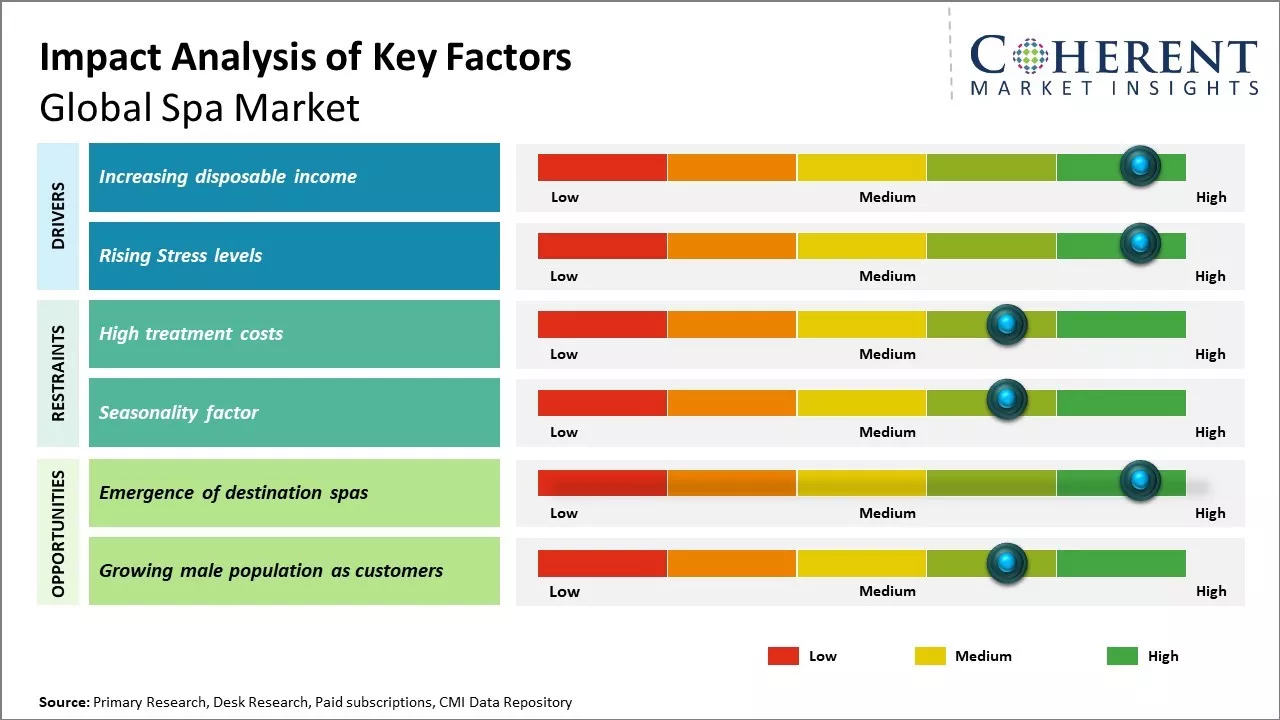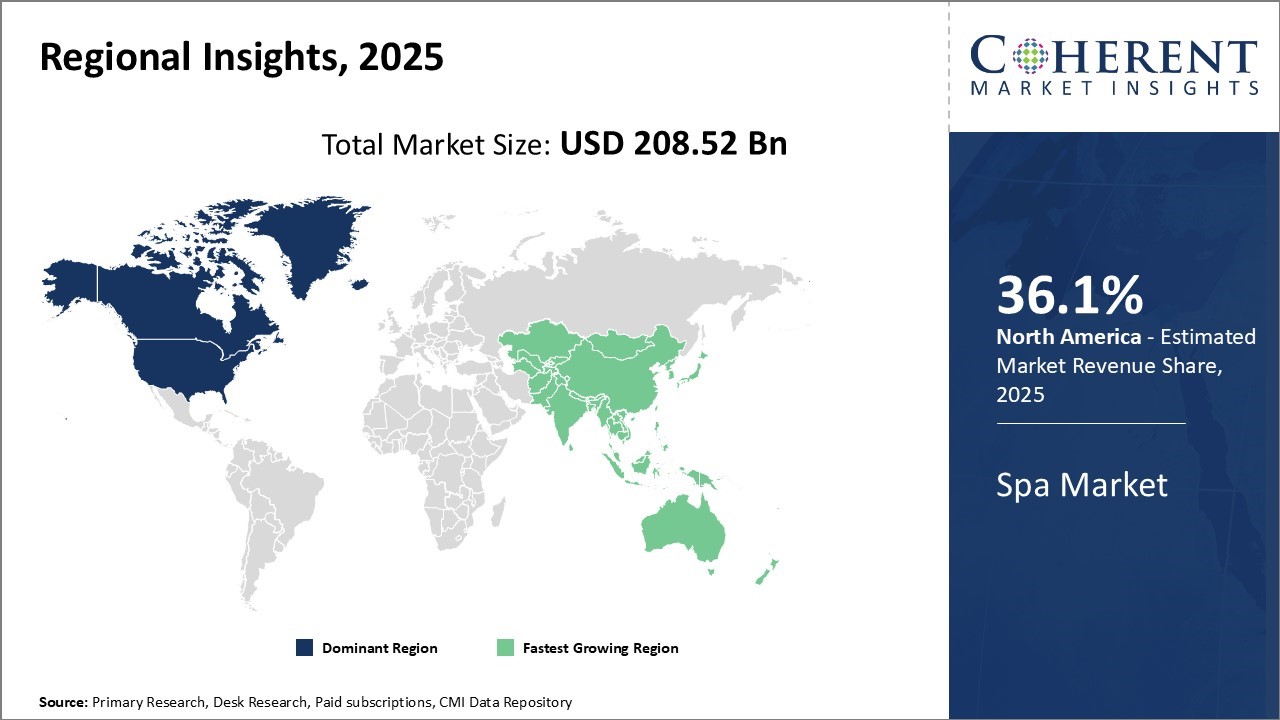The global spa market is estimated to be valued at USD 208.52 Bn in 2025 and is expected to reach USD 512.56 Bn by 2032, exhibiting a compound annual growth rate (CAGR) of 13.7% from 2025 to 2032.

To learn more about this report, Download Free Sample
The spa market grows steadily as more people prioritize wellness, manage lifestyle stress, and seek holistic health solutions. Consumers actively choose personalized and convenient services like massages, facials, and medical spa treatments. Urban living, rising incomes, and a growing focus on self-care drive this demand across diverse groups. Spa providers adopt technology, embrace sustainability, and tap into wellness tourism to enrich client experiences. The industry expands by forming hotel partnerships, offering mobile services, and introducing innovative treatments that meet changing customer needs.
|
Current Events |
Description and its impact |
|
Macro-Level Economic Developments |
|
|
Regional Geopolitical and Regulatory Events |
|
|
Nano-Level Consumer Behavior and Lifestyle Trends |
|
Uncover macros and micros vetted on 75+ parameters: Get instant access to report
AI is transforming the spa industry by enhancing efficiency, personalization, and overall guest experience. Intelligent systems, such as robotic massage devices, help address staffing shortages by operating continuously and supporting therapists with routine tasks like muscle-warming treatments. AI also enables customized wellness experiences by analyzing client preferences and physical needs in real time. From automating bookings to optimizing treatment plans, AI streamlines operations and improves service quality.
In October 2024, Aescape launched its first hospitality partnership in Nashville at R+R Wellness in the Grand Hyatt, offering AI-powered automated massage to meet growing demand for personalized wellness solutions. Also, in July 2025, Ionto-Comed introduced iRiS, an intelligent robotic massage system designed to address spa therapist shortages by operating 24/7, reducing labor costs, and easing therapist workload. iRiS can handle the muscle-warming phase before therapist-led treatments and stands out for combining AI precision with practical support for spa professionals.
Massage Therapies acquired the prominent share of 36.1% in 2025. Massage therapy offers numerous health benefits such as improved circulation, relief from muscle tension and pain. With rising health consciousness, people are increasingly turning to massage as a way to unwind from daily pressures. The fast-paced urban lifestyle has led to higher incidence of stress-related issues, driving the demand for therapeutic massage services. Additionally, massage is becoming more mainstream as a self-care and self-indulgence activity. Several high-end spas have enhanced their offerings by providing specialized massages using natural ingredients or innovative techniques like hot stone massage. Greater acceptance of complementary treatments and focus on incorporating Eastern practices of wellness in daily lives have boosted the popularity of massage therapies globally.
In December 2024, Hand & Stone Massage and Facial Spa recently launched its public Learning Management System (LMS) to manage educational lectures, training programs, and learning and development courses. The platform offers free select courses to help all licensed massage therapists meet their continuing education requirements, extending access beyond just those employed by the brand.
Day Spas dominates the overall market with an estimated share of 40.2% in 2025. Their flexible operating hours fitting busy schedules have made day spas extremely accessible to working professionals and families. Not requiring an overnight stay allows patrons to schedule sessions anytime during weekdays or weekends based on their availability. This quality of fitting easily into consumers’ lifestyles without disrupting routines has ensured day spas attract high footfall. The thriving real estate of branded day spa chains across major cities provides customers with a standardized experience wherever they are based. Their diverse service packages catering to specific needs like bridal, group, or teenager services have further amplified the appeal of day spas. For instance, Italian day spa QC Terme prepared to open its newest location—and its first outside of Europe—on Governors Island in the middle of New York Harbor. They have started selling tickets for QC NY, along with available entry dates.
Women hold the largest market share of 66.1% in 2025. The spa market has tailored its offerings to cater to the diverse needs and preferences of women, who seek a wide range of treatments, services, and experiences to enhance their overall well-being. From luxurious massage therapies and rejuvenating facials to specialized body treatments and holistic wellness programs, the spa market has evolved to provide a comprehensive range of services that resonate with the female clientele.
In January 2025, The Spa by Equinox Hotels partnered with Stripes Beauty, a pro-aging wellness brand, to support women through perimenopause and menopause. This collaboration combines results-driven treatments with education and innovative solutions to address the physical and emotional needs of women during hormonal changes, promoting confidence and accessible care.

To learn more about this report, Download Free Sample
North America dominates the overall market with an estimated share of 36.1% in 2025. Increasing demand for wellness and self-care drives the North America spa market as more consumers seek stress relief and holistic treatments. Medical spas attract growing attention with their cosmetic and anti-aging services. Technology enhances personalization and convenience through digital bookings and advanced therapies. Luxury hotel spas continue to draw clients, while wellness tourism boosts market expansion. Consumers also show rising interest in sustainable and eco-friendly practices, and the market grows further as men and younger generations actively engage with spa services. For instance, in March 2025, Pause, a state-of-the-art wellness studio focused on modern and holistic solutions, announced its expansion to Fort Lauderdale, FL, marking the West Coast brand’s first location in South Florida. Pause offers a tranquil and sophisticated spa sanctuary that aims to revolutionize the wellness space by delivering a wide range of holistic services designed to nurture both the mind and body and support overall wellbeing.
Rising health consciousness and urban lifestyle stress drive consumers in Asia Pacific to seek wellness and spa services. They actively pursue holistic and traditional therapies alongside modern treatments to enhance their physical and mental well-being. This growing awareness boosts spa popularity across various age groups and regions. Additionally, ancient healing practices like Ayurveda, Herbal Medicine, and Balinese massage continue to attract local clients and wellness tourists, carving a unique niche focused on natural and holistic healing. For instance, in June 2025, Meliá Pattaya Hotel unveiled its YHI Spa with a menu affording an array of health benefits, such as improving metabolism and the nervous and lymphatic systems, to ease stress, anxiety, headaches and sleep problems.
Consumers across India are increasingly aware of health and wellness, driving demand for spa services. They actively seek stress relief and rejuvenation through both modern and traditional treatments, boosting spa visits in urban and semi-urban areas. Medical spas rapidly expand, offering cosmetic, dermatological therapeutics, and anti-aging treatments. Rising disposable incomes and advanced technology give urban consumers greater access to these specialized services. Spas also enhance convenience and engagement by adopting digital tools, appealing especially to younger, tech-savvy customers. For instance, in August 2025, Carlton London unveiled Carlton Wellness Spa, a chain of luxury wellness spas in malls and resort properties, marking its first entry into health and well-being experiences in India.
Chinese consumers actively prioritize wellness and stress relief amid fast-paced urban lifestyles. Spas that offer relaxation, mental health support, and holistic wellness treatments gain popularity in major cities and emerging urban areas. Traditional Chinese Medicine therapies like acupuncture, cupping, and herbal treatments continue to play a key role, attracting locals and tourists seeking authentic wellness experiences. The government supports the expansion of spa resorts and wellness destinations, encouraging both domestic and international tourists to explore culturally rich and luxurious spa offerings, driving market growth. For instance, The PuYu Hotel & Spa in Wuhan, China finalized the last details of its new spa. The Akasuri treatment, rooted in Japanese tradition, begins with a short visit to the steam room or sauna to soften the skin. Therapists then perform a loofah scrub to remove dead skin, followed by a restorative hot oil massage.
| Report Coverage | Details | ||
|---|---|---|---|
| Base Year: | 2024 | Market Size in 2025: | USD 208.52 Bn |
| Historical Data for: | 2020 To 2024 | Forecast Period: | 2025 To 2032 |
| Forecast Period 2025 to 2032 CAGR: | 13.7% | 2032 Value Projection: | USD 512.56 Bn |
| Geographies covered: |
|
||
| Segments covered: |
|
||
| Companies covered: |
Mandara Spa, Woodhouse Spas, Hand & Stone Franchise Corp, Hyatt Hotel Corporation, Four Seasons Hotel Limited, Marriot International, Inc., Hilton Hotels & Resorts, OneSpaWorld Holdings Limited, InterContinental Hotels Group Plc, Banyan Tree Hotels & Resorts, Carmel Valley Ranch, Ojai Valley Inn., The Greenwichhotel, Healing Hotels of the World, Siam Wellness Group, Spaandwellness, Chiva-Som, Amatara Welleisure Resort, Niyama Spa, and SoulSense Spa |
||
| Growth Drivers: |
|
||
| Restraints & Challenges: |
|
||
Uncover macros and micros vetted on 75+ parameters: Get instant access to report
Consumers increasingly prioritize wellness and self-care as essential parts of their lifestyle. They seek spa treatments not just for relaxation but for mental health, stress reduction, and overall well-being. This shift encourages spas to offer holistic services combining physical therapies with mindfulness, nutrition, and fitness. The emphasis on preventive health and emotional balance drives demand, making wellness an integral part of everyday life rather than a luxury experience.
Medical and cosmetic spas are rapidly growing, offering advanced treatments like laser therapy, injectables, and skin rejuvenation. These spas bridge healthcare and beauty, appealing to clients seeking non-invasive, results-driven solutions. Technological advancements and rising awareness of aesthetic procedures fuel this trend, while regulatory support ensures safety and quality. The growth of medical spas also reflects changing beauty standards and consumer willingness to invest in long-term skin and body care.
Spas can leverage technology to improve service delivery and customer engagement. Virtual consultations, AI-driven personalized treatments, and mobile apps streamline booking and enhance experiences. Innovations like VR relaxation, wearable wellness devices, and advanced skin diagnostics create new service avenues. Investing in digital transformation not only meets rising consumer expectations but also boosts operational efficiency and marketing effectiveness, positioning spas as modern, tech-savvy wellness destinations.
In August 2025, iHealth Marketing, a top medspa marketing firm, announced the launch of its new MedSpa Marketing services, aimed at helping medical spas throughout the U.S. enhance their visibility, attract premium clients, and grow their revenue.
Share
Share
About Author
Sakshi Suryawanshi is a Research Consultant with 6 years of extensive experience in market research and consulting. She is proficient in market estimation, competitive analysis, and patent analysis. Sakshi excels in identifying market trends and evaluating competitive landscapes to provide actionable insights that drive strategic decision-making. Her expertise helps businesses navigate complex market dynamics and achieve their objectives effectively.
Missing comfort of reading report in your local language? Find your preferred language :
Transform your Strategy with Exclusive Trending Reports :
Frequently Asked Questions
Joining thousands of companies around the world committed to making the Excellent Business Solutions.
View All Our Clients